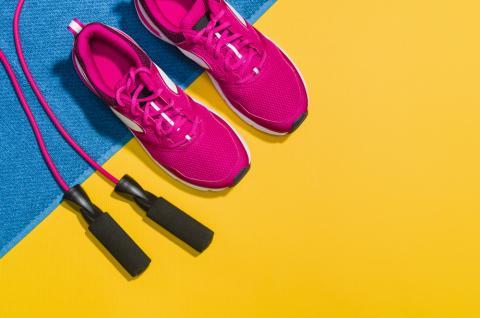
Bone is living tissue, meaning that how we treat it is how it will respond (in most cases). Osteoporosis—a condition in which bones become brittle and easily broken—and osteopenia—the thinning of bones—are life-changing conditions that can result in a number of problems, including fractures and joint pain. Our bone mass peaks before the age of 30, meaning that how we treat our bones, including what we eat and how we exercise, has massive implications for our life decades down the road. Here’s why you should prioritize bone health (no matter your age!), how to eat well to support strong bones, and how to build them in the gym.
Why do strong bones matter?
The National Institute of Arthritis and Musculoskeletal and Skin Diseases doesn’t mess around. In a section titled “Healthy Bones Matter,” the institute states this: “If you don’t do the best you can now to make your bones strong, you might get osteoporosis when you are older.” Bones, primarily composed of collagen and calcium, are both strong and flexible, allowing us to stay rigid under stress. Throughout childhood, new bone is continually added; somewhere after adolescence, which for most people is around age 20, this process stops. At age 30, we lose more bone than is made. If this intensifies past a certain point, osteoporosis is possible. As such, it’s important for us to do all that we can to keep our bones strong.
What should I eat?
As you might imagine, diet plays a crucial role in keeping your bones strong. Most people believe that dairy products–thanks to calcium—are integral, but a 2014 study that looked at thousands of women and men over nearly two decades found no correlation between milk intake and a reduction of bone fractures. Rather, the study concluded that “high milk intake was associated with higher mortality in one cohort of women and in another cohort of men, and with higher fracture incidence in women.”
Calcium is crucial for proper bone development, but it’s not the addition of calcium that’s important: it’s negating calcium loss. As Josh Gitalis, Certified Nutritional Practitioner and Clinical Nutritionist, explains, it comes down to several factors: vitamin D deficiency, low stomach acid, caffeine consumption, and a lack of exercise. While it’s worth rethinking your dairy consumption, it doesn’t mean writing off calcium altogether. There are terrific non-acidic dairy sources available, including salmon, sesame seeds, sardines, almonds, and, best of all, green leafy vegetables: collards, spinach, turnip greens, and kale.
Are there any supplements I should be taking?
It’s worth noting that certain supplements can help to ensure that you’re receiving the necessary nutrients you need to build strong bones, though they can never be a complete substitute for a healthy, vibrant diet. Still, there are some supplements you might consider adding after consulting with your doctor.
- Magnesium: A 2013 study published by the American Academy of Pediatrics found that magnesium is just as important as calcium to kids’ bone health.
- Vitamin D: Vitamin D stimulates the absorption of calcium from the gut, as a 2011 study titled “The effect of vitamin D on bone and osteoporosis” points out.
How should I exercise?
Exercise is vital for strong bones, but there can be confusion about what type of exercise is best suited for bone health. The National Institute of Arthritis and Musculoskeletal and Skin Diseases suggests that weight-bearing activity is best, as it forces you to work against gravity. An in-depth study and explanation published on Strength & Conditioning Research found that strength training is a terrific way to increase bone mineral density—another way of talking about the strength of your bones. While walking, running, and riding a bike are all great forms of exercise, resistance is the key to building stronger bones.
Where do I go from here?
If you’re unfamiliar with the weight room, try talking to a coach to see if you might arrange a few sessions to learn more about the equipment and find a routine that works for you. As a sample, here are some exercises that work the whole body and contribute to stronger, healthier bones:
- squats
- deadlifts
- bench press
- shoulder press
- weighted lunges
- kettlebell swings








